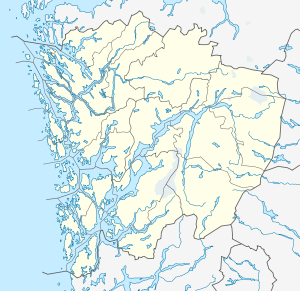Leirvik
| Leirvik Stord | |
|---|---|
| Town | |
 View of the town harbor area | |
 Leirvik Location in Hordaland county | |
| Coordinates: 59°46′47″N 05°30′01″E / 59.77972°N 5.50028°ECoordinates: 59°46′47″N 05°30′01″E / 59.77972°N 5.50028°E | |
| Country | Norway |
| Region | Western Norway |
| County | Hordaland |
| District | Sunnhordland |
| Municipality | Stord |
| Area[1] | |
| • Total | 9.52 km2 (3.68 sq mi) |
| Elevation[2] | 2 m (7 ft) |
| Population (2013)[1] | |
| • Total | 13,478 |
| • Density | 1,416/km2 (3,670/sq mi) |
| Time zone | UTC+01:00 (CET) |
| • Summer (DST) | UTC+02:00 (CEST) |
| Post Code | 5417 Stord |
Leirvik is a town and the administrative centre of Stord municipality in Hordaland county, Norway. The town lies along the southern coast of the large island of Stord, along the Hardangerfjorden. The town gained "town status" in 1997. The town includes the Eldøyane peninsula where the large Kværner Stord industrial area is located.[3]

Leirvik is the regional centre of the traditional district of Sunnhordland, and has many public services and offices such as the Sunnhordland District court and the Sunnhordland Museum, as well as many shops and restaurants. Stord Church and several schools such as Stord Upper Secondary School and Western Norway University of Applied Sciences are all located in the town.[3]
The 9.52-square-kilometre (2,350-acre) town has a population (2013) of 13,478. This gives it a population density of 1,416 inhabitants per square kilometre (3,670/sq mi).[1] The entire municipality has about 18,000 residents in it (2013), so Leirvik has over 70% of the total population of the municipality. Leirvik is also the largest urban area that is located in a municipality where Nynorsk is the preferred language form.
Transportation
The town lies along the European route E39 highway, just east of the Stord Bridge which is part of the Triangle Link which connects a number of islands to the mainland via road bridges and an undersea tunnel. There is a ferry quay at Kåravika in the western part of the town which has regular ferry connections to the nearby islands of Halsnøya, Fjelbergøya, and Borgundøya which lie to the east in the Hardangerfjorden. A regular ferry connection to the nearby island of Huglo departs just north of Leirvik at the quay at Jektavik.
Media
The newspaper Sunnhordland is published in Leirvik,[4] as well as the online newspaper Stord24. NRK also has a local office in Leirvik.
Name
Confusingly, when the municipality of Stord declared that Leirvik was a town in 1997, they decided to name the town "Stord", with the village of Leirvik being the central part of the town. This was done because the Norwegian government required a populated place to have at least 5,000 residents in order to be called a town. Leirvik alone did not have enough residents unless the whole surrounding areas were also included, so the name "Stord" would represent the whole area. Even though this is the official name, the public acceptance of this has been minimal and controversial, and the name of the urban community remains "Leirvik".[5][6]
The name Leirvik (Old Norse: Leirvík) translates into "clay bay". The word "leire" meaning "clay" and "vik" meaning "bay".[7] The name comes from the high concentration of clay in the ground. The locals often colloquially refer to Leirvik by the name "Vikjo", meaning "the bay" in local dialect, rather than "Leirvik".
References
- 1 2 3 Statistisk sentralbyrå (1 January 2013). "Urban settlements. Population and area, by municipality".
- ↑ "Leirvik, Stord (Hordaland)" (in Norwegian). yr.no. Retrieved 2015-02-04.
- 1 2 Store norske leksikon. "Leirvik – tettsted i Stord" (in Norwegian). Retrieved 2015-02-03.
- ↑ Mediebedriftene: Sunnhordland.
- ↑ "Heiter byen Stord eller Leirvik?". Sunnhordland (in Norwegian). 2007-01-31. Archived from the original on 2015-02-05.
- ↑ "Skal Stord skifta namn no?". Sunnhordland (in Norwegian). 2008-07-31. Archived from the original on 2015-02-05.
- ↑ Rygh, Oluf (1910). Norske gaardnavne: Søndre Bergenhus amt (in Norwegian) (11 ed.). Kristiania, Norge: W. C. Fabritius & sønners bogtrikkeri. p. 144.
